3.5 Energy transfers in and between organisms
1/47
There's no tags or description
Looks like no tags are added yet.
Name | Mastery | Learn | Test | Matching | Spaced |
|---|
No study sessions yet.
48 Terms
What are the stages of photosynthesis? Where does each process take place?
1. Light dependent reaction
○ Thylakoid membrane of chloroplast
2. Light independent reaction
○ Stroma of chloroplast
Describe photoionisation in the light-dependent reaction (LDR)
● Chlorophyll absorbs light energy which excites its electrons (higher energy level)
● So electrons are released from chlorophyll (chlorophyll becomes positively charged)
Describe what happens after photoionisation in the LDR
1. Electrons move along electron transfer chain (electron carriers), releasing energy
2. This energy is used to actively pump protons from stroma into thylakoid
3. Protons move by facilitated diffusion down electrochemical gradient into stroma via ATP synthase
4. Energy used to join ADP and Pi to form ATP (photophosphorylation)
5. NADP accepts a proton and an electron to become reduced NADP
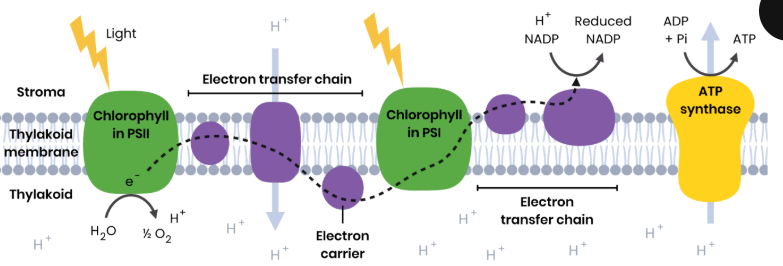
Describe photolysis of water in the LDR
● Water splits to produce protons, electrons and oxygen (H2O → 1⁄2 O2 + 2e- + 2H+)
○ Electrons replace those lost from chlorophyll
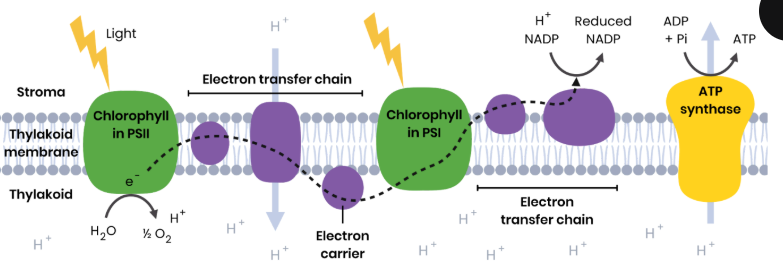
Describe the light-independent reaction of photosynthesis (Calvin cycle)
1. CO2 reacts with ribulose bisphosphate (RuBP)
○ Catalysed by the enzyme rubisco
2. Forming 2 glycerate 3-phosphate (GP) molecules
3. GP reduced to triose phosphate (TP)
○ Using products from light-dependent reaction - reduced NADP and energy from ATP
4. Some TP converted to useful organic substances (eg. glucose)
5. Some TP used to regenerate RuBP in the Calvin cycle (using energy from ATP)

Describe and explain how temperature affects rate of photosynthesis
1. As temperature increases, rate increases
○ Enzymes eg. rubisco gain kinetic energy
○ So more enzyme-substrate complexes form
2. Above an optimum temperature, rate decreases
○ Enzymes denature as H bonds in tertiary structure break
○ So fewer enzyme-substrate complexes form
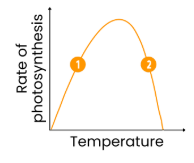
Describe and explain how light intensity affects rate of photosynthesis
1. As light intensity increases, rate increases
○ Light-dependent reaction increases (eg. more photoionisation of chlorophyll) so more ATP and reduced NADP produced
○ So light-independent reaction increases as more GP reduced to TP and more TP regenerates RuBP
2. Above a certain light intensity, rate stops increasing
○ Another factor is limiting eg. temperature / CO2 concentration
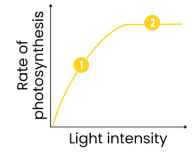
Describe and explain how CO2 concentration affects rate of photosynthesis
1. As CO2 concentration increases, rate increases
○ Light-independent reaction increases
○ As more CO2 combines with RuBP to form GP
○ So more GP reduced to TP
○ So more TP converted to organic substances and more RuBP regenerated
2. Above a certain CO2 concentration, rate stops increasing
○ Another factor is limiting eg. temperature / light intensity
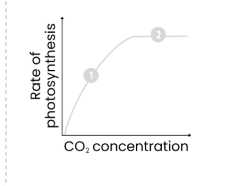
Explain the key consideration when evaluating data relating to agricultural practices used to overcome the effect of limiting factors
● Agricultural practice should increase rate of photosynthesis, leading to increased yield
○ As more glucose produced for faster respiration
○ So more ATP to release energy for growth eg. cell division, protein synthesis
● But profit from extra yield should be greater than costs (money & environmental costs)
Why is respiration important?
● Respiration produces ATP (to release energy)
● For active transport, protein synthesis etc.
Summarise the stages of aerobic & anaerobic respiration and where they occur
Aerobic respiration:
1. Glycolysis - cytoplasm (anaerobic)
2. Link reaction - mitochondrial matrix
3. Krebs cycle - mitochondrial matrix
4. Oxidative phosphorylation - inner mitochondrial membrane
Anaerobic respiration:
1. Glycolysis - cytoplasm
2. NAD regeneration - cytoplasm
Describe the process of glycolysis
1. Glucose phosphorylated to glucose phosphate
○ Using inorganic phosphates from 2 ATP
2. Hydrolysed to 2 x triose phosphate
3. Oxidised to 2 pyruvate
○ 2 NAD reduced
○ 4 ATP regenerated (net gain of 2)
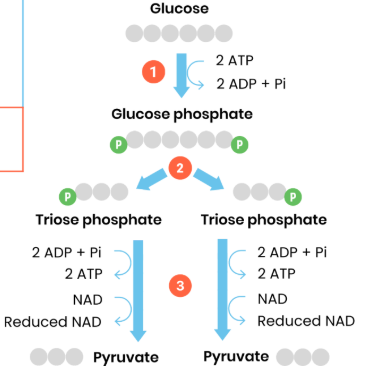
Explain what happens after glycolysis if respiration is anaerobic
1. Pyruvate converted to lactate (animals & some bacteria) or ethanol (plants & yeast)
2. Oxidising reduced NAD → NAD regenerated
3. So glycolysis can continue (which needs NAD) allowing continued production of ATP
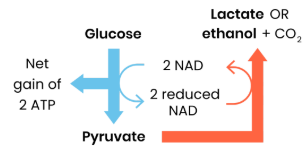
Suggest why anaerobic respiration produces less ATP per molecule of glucose than aerobic respiration
● Only glycolysis involved which produces little ATP (2 molecules)
● No oxidative phosphorylation which forms majority of ATP (around 34 molecules)
What happens after glycolysis if respiration is aerobic?
Pyruvate is actively transported into the mitochondrial matrix
Describe the link reaction
1. Pyruvate oxidised (and decarboxylated) to acetate
○ CO2 produced
○ Reduced NAD produced (picks up H)
2. Acetate combines with coenzyme A, forming Acetyl Coenzyme A
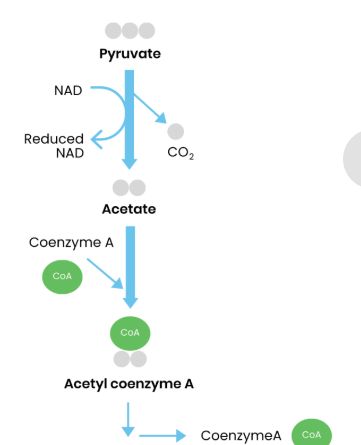
Products per glucose molecule
2 x Acetyl Coenzyme A,
2 X CO2
and 2 X reduced NAD
Describe the Krebs cycle
1. Acetyl coenzyme A (2C) reacts with a
4C molecule
○ Releasing coenzyme A
○ Producing a 6C molecule that enters the Krebs cycle
2. In a series of oxidation-reduction reactions, the 4C molecule is regenerated and:
○ 2 x CO2 lost
○ Coenzymes NAD & FAD reduced
○ Substrate level phosphorylation (direct transfer of Pi from intermediate compound to ADP) → ATP produced
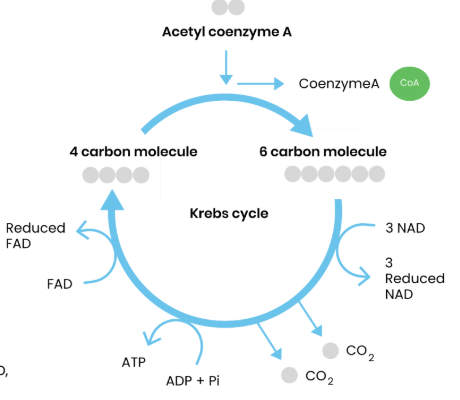
Products per glucose molecule:
6 x reduced NAD,
2 x reduced FAD,
2 x ATP
and 4 x CO2
Describe the process of oxidative phosphorylation
1. Reduced NAD/FAD oxidised to release H atoms → split into protons (H+) and electrons (e-)
2. Electrons transferred down electron transfer chain (chain of carriers at decreasing energy levels)
○ By redox reactions
3. Energy released by electrons used in the production of ATP from ADP + Pi (chemiosmotic theory):
○ Energy used by electron carriers to actively pump protons from matrix → intermembrane space
○ Protons diffuse into matrix down an electrochemical gradient, via ATP synthase (embedded)
○ Releasing energy to synthesise ATP from ADP + Pi
4. In matrix at end of ETC, oxygen is final electron acceptor (electrons can’t pass along otherwise)
○ So protons, electrons and oxygen combine to form water

Give examples of other respiratory substrates
Breakdown products of lipids and amino acids, which enter the Krebs cycle. For example:
● Fatty acids from hydrolysis of lipids → converted to Acetyl Coenzyme A
● Amino acids from hydrolysis of proteins → converted to intermediates in Krebs cycle
What is gross primary production (GPP)?
● Chemical energy store in plant biomass, in a given area or volume, in a given time
○ Total energy transferred into chemical energy from light energy during photosynthesis
What is net primary production (NPP)?
Chemical energy store in plant biomass after respiratory losses to environment taken into account
State the formula for NPP
NPP = GPP – R
R = respiratory losses to the environment
Explain the importance of NPP in ecosystems
● NPP is available for plant growth and reproduction
● NPP is also available to other trophic levels in the ecosystem, such as herbivores and decomposers
What is primary or secondary productivity?
The rate of primary or secondary production, respectively
State the units used for primary or secondary productivity
kJ ha-1 year-1
(unit for energy, per unit area, per year)
Explain why these units for primary or secondary productivity are used
● Per unit area → takes into account that different environments vary in size
○ Standardising results to enable comparison between environments
● Per year → takes into account effect of seasonal variation (temperature etc.) on biomass
○ More representative and enables comparison between environments
Explain why most light falling on producers is not used in photosynthesis
● Light is reflected or wrong wavelength
● Light misses chlorophyll / chloroplasts / photosynthetic tissue
● CO2 concentration or temperature is a limiting factor
State the formula for net production of consumers (N)
N = I – (F + R)
I = the chemical energy store in ingested food
F = the chemical energy lost to the environment in faeces and urine
State the formula for efficiency of energy transfer
Energy or biomass available after transfer / energy or biomass available before transfer x 100 if a %
Explain why energy transfer between trophic levels is inefficient
● Heat energy is lost via respiration
● Energy lost via parts of organism that aren’t eaten (eg. bones)
● Energy lost via food not digested → lost as faeces
● Energy lost via excretion eg. urea in urine
Explain how crop farming practices increase energy transfer efficiency
● Simplifying food webs to reduce energy / biomass losses to non-human food chains eg.
○ Herbicides kill weeds → less competition (eg. for light) so more energy to create biomass
○ Pesticides kill insects (pests) → reduce loss of biomass from crops
○ Fungicides reduce fungal infections → more energy to create biomass
● Fertilisers e.g. nitrates to prevent poor growth due to lack of nutrients
Explain how livestock farming practices increase energy transfer efficiency
● Reducing respiratory losses within a human food chain (so more energy to create biomass):
○ Restrict movement and keep warm → less energy lost as heat from respiration
○ Slaughter animal while still growing / young, when most of their energy is used for growth
○ Treated with antibiotics → prevent loss of energy due to pathogens
○ Selective breeding to produce breeds with higher growth rates
Explain the role of saprobionts in recycling chemical elements
● Decompose (break down) organic compounds eg. proteins / urea / DNA in dead matter / organic waste
● By secreting enzymes for extracellular digestion (saprobiotic nutrition)
● Absorb soluble needed nutrients and release minerals ions eg. phosphate ions
Explain the role of mycorrhizae
Mycorrhizae = symbiotic association between fungi and plant roots
● Fungi (hyphae) act as an extension of plant roots to increase surface area of root system
● To increase rate of uptake / absorption of water and inorganic ions
● In return, fungi receive organic compounds eg. carbohydrates
Give examples of biological molecules that contain nitrogen
Amino acids / proteins or enzymes / urea / DNA or RNA / chlorophyll / ATP or ADP / NAD or NADP
Draw a diagram to show the key stages of the nitrogen cycle
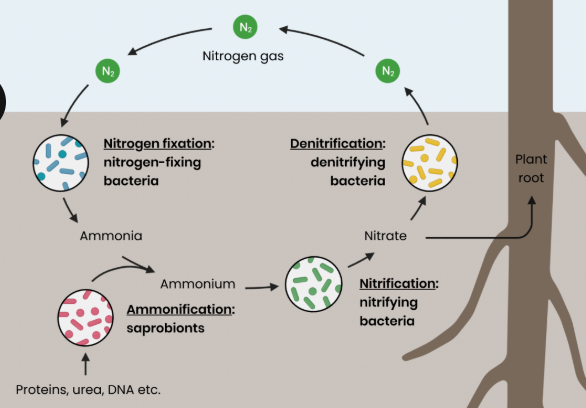
Describe the role of bacteria in nitrogen fixation
● Nitrogen gas (N2) converted into ammonia (NH3), which forms ammonium ions (NH4+) in soil
● By nitrogen-fixing bacteria (may be found in root nodules)
Describe the role of bacteria in nitrification
● Ammonium ions in soil converted into nitrites then nitrates, via a two-step oxidation reaction
○ For uptake by plant root hair cells by active transport
● By nitrifying bacteria in aerobic conditions (oxygen)
Describe the role of bacteria in denitrification
● Nitrates in soil converted into nitrogen gas (reduction)
● By denitrifying bacteria in anaerobic conditions (no oxygen, eg. waterlogged soil)
Suggest why ploughing (aerating) soil increases its fertility
● More ammonium converted into nitrite and nitrate / more nitrification / more (active) nitrifying bacteria
● Less nitrate converted to nitrogen gas / less denitrification / fewer (active) denitrifying bacteria
Give examples of biological molecules that contain phosphorus
Phospholipids / DNA or RNA / ATP or ADP / NADP / TP or GP / RuBP
Describe the phosphorus cycle
1. Phosphate ions in rocks released (into soils / oceans) by erosion / weathering
2. Phosphate ions taken up by producers / plants / algae and incorporated into their biomass
○ Rate of absorption increased by mycorrhizae
3. Phosphate ions transferred through food chain eg. as herbivores eat producers
4. Some phosphate ions lost from animals in waste products (excretion)
5. Saprobionts decompose organic compounds eg. DNA in dead matter / organic waste,
releasing phosphate ions
Explain why fertilisers are used
● To replace nitrates / phosphates lost when plants are harvested and livestock are removed
○ Those removed from soil and incorporated into biomass can’t be released back into the soil through decomposition by saprobionts
● So improve efficiency of energy transfer → increase productivity / yield
Describe the difference between artificial and natural fertilisers
Natural:
● Organic, eg. manure, compost, sewage
● Ions released during decomposition by saprobionts
Artificial:
●Contain inorganic compounds of nitrogen, phosphorus and potassium
Explain the key environmental issue arising from use of fertilisers
● Phosphates / nitrates dissolve in water, leading to leaching of nutrients into lakes / rivers / oceans
● This leads to eutrophication
1. Rapid growth of algae in pond / river (algal bloom) so light blocked
2. So submerged plants die as they cannot photosynthesise
3. So saprobionts decompose dead plant matter, using oxygen in aerobic respiration
4. So less oxygen for fish to aerobically respire, leading to their death
Explain the key advantage of using natural fertiliser over artificial fertiliser
● Less water soluble so less leaching → eutrophication less likely
● Organic molecules require breaking down by saprobionts → slow release of nitrate / phosphate etc.